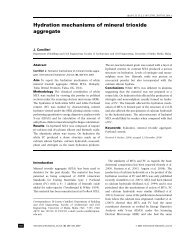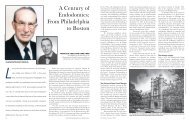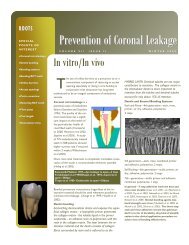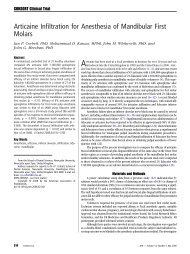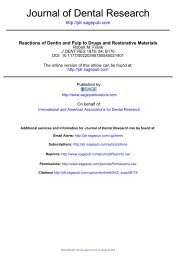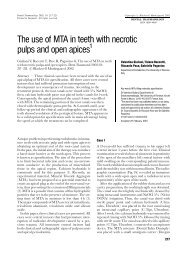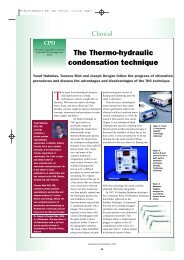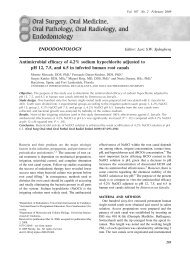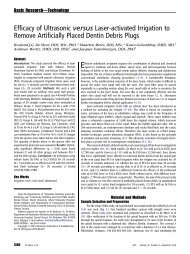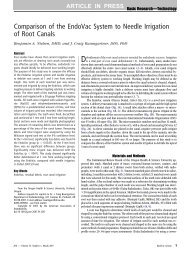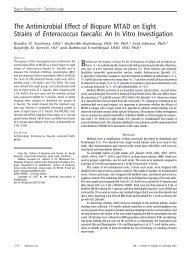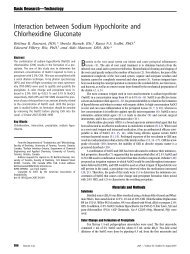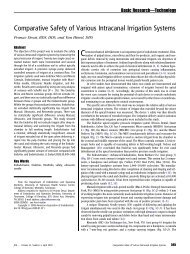Dens invaginatus - The EndoExperience
Dens invaginatus - The EndoExperience
Dens invaginatus - The EndoExperience
Create successful ePaper yourself
Turn your PDF publications into a flip-book with our unique Google optimized e-Paper software.
82 M. Hülsmann<br />
Fig. 4 Classification of dens <strong>invaginatus</strong> by Schulze & Brand (1972)<br />
(from: Zahnärztliche Welt/Reform 81, 569–73, with kind permission).<br />
Swanson & McCarthy (1947) were the first to present<br />
bilateral dens <strong>invaginatus</strong> malformation, Conklin<br />
(1968) presented a patient with all maxillary central<br />
and lateral incisors affected, and Burton et al. (1980)<br />
Table 1 Investigations on the prevalence of dens <strong>invaginatus</strong><br />
published a case with six teeth involved, the maxillary<br />
incisors and also the maxillary canines. Krolls (1969)<br />
detected dental invaginations in maxillary central<br />
incisors as well as in several maxillary and mandibular<br />
bicuspids in one patient. Conklin (1978) found the<br />
anomaly in four mandibular incisors in one patient.<br />
Double invaginations in one tooth were reported by<br />
Rushton (1937), Archer & Silverman (1950), Oehlers<br />
(1957a), Grahnen et al. (1959), Ulmansky & Hermel<br />
(1964), Schulze & Brand (1972), Brill & Phillips (1974),<br />
Bhatt & Dholakia (1975), Conklin (1975), Cole et al.<br />
(1978), Gotoh et al. (1979), Mader (1979), Rotstein<br />
et al. (1987a), and Vairabhaya (1989). Triple invaginations<br />
were described by Hitchin & McHugh (1954) and<br />
Mader (1977). In rare cases even primary teeth seem to<br />
be affected (Rabinowitch 1952).<br />
Cases of dental invaginations in supernumerary teeth<br />
have been presented as well as in canines and bicuspids<br />
(Archer & Silverman 1950, Schwenzer 1957, Kruse<br />
1962, Klammt 1969, Conklin 1975, Banner 1978,<br />
Author/Country Year Sample Frequency<br />
Mühlreiter 1873 500 extracted lateral maxillary 2.8% of teeth<br />
(Austria) incisors (histological investigation)<br />
Atkinson 1943 500 lateral maxillary incisors 10% of teeth<br />
(USA)<br />
Boyne 1952 1000 maxillary incisors 0.3% of teeth<br />
(USA)<br />
Stephens 1953 150 full-mouth surveys 8%<br />
(unknown) 1953 1000 patients 3.6% (cited by Hovland & Block 1977)<br />
Shafer 1953 2542 full-mouth surveys 1.3% of patients<br />
(USA) (cited by Hovland & Block 1977)<br />
Hallet 1953 586 full-mouth surveys 6.6% of maxillary lateral incisors<br />
(unknown) 0.5% of maxillary central incisors<br />
(cited by Hovland & Block 1977)<br />
Amos 1955 1000 full mouth surveys 5.1% of patients<br />
(USA) 203 full mouth surveys 6.9% (students of dentistry)<br />
Grahnen et al. 1959 3020 right maxillary incisors 2.7% of patients<br />
(Sweden)<br />
Ulmansky & 1964 500 full mouth surveys 2% of patients<br />
Hermel (Israel)<br />
Poyton & Morgan 1966 5000 full mouth surveys 0.25% of patients<br />
(Canada) (cited by Hovland & Block 1977)<br />
Miyoshi et al. 1971 extracted maxillary lateral 38.5% of teeth<br />
( Japan) incisors (cited by Gotoh et al. 1979)<br />
Fujiki et al. 1974 2126 lateral maxillary incisors 4.2% of teeth<br />
( Japan) (cited by Gotoh et al. 1979)<br />
Thomas 1974 1886 full mouth surveys 7.74% of patients<br />
(USA)<br />
Gotoh et al. 1979 766 lateral maxillary incisors 9.66% of teeth<br />
( Japan)<br />
Ruprecht et al. 1986 1581 full mouth surveys 1.7% of patients<br />
(Saudi Arabia)<br />
Ruprecht et al. 1987 300 full mouth surveys 10% of patients<br />
(Saudi Arabia)<br />
© 1997 Blackwell Science Ltd, International Endodontic Journal, 30, 79–90



